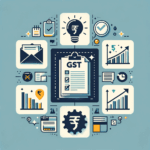Future Trends in GST Compliance: What to Expect in 2025
Since its rollout in 2017, India’s Goods and Services Tax (GST) has been in a constant state of evolution. For business owners, staying on top of these changes isn’t just good practice—it’s essential for survival and growth. As we look towards 2025, the GST ecosystem is poised for another significant leap, driven by technology and data. This article explores the key future trends compliance experts are forecasting, moving the entire system towards greater transparency and automation. For small business owners and freelancers in India, understanding these upcoming future trends compliance 2025 India is crucial to avoid penalties, streamline operations, and stay ahead of the curve. These changes are not just procedural updates; they represent a fundamental shift in how the government monitors transactions, making proactive adaptation a necessity for every registered taxpayer. Fulfilling your expectations for GST compliance India will soon rely heavily on your digital readiness.
The Current Landscape: A Quick Recap of GST Compliance
Before diving into the future, it’s important to understand where we stand today. The current GST framework has digitized tax compliance to a great extent but still comes with its own set of challenges and processes that every business must navigate. This foundation is the launchpad for all the technological advancements we are about to witness.
Key Pillars of Today’s GST System
The modern GST system is built on a few core components that businesses interact with regularly:
- GSTR-1 and GSTR-3B: These are the two primary returns. GSTR-1 is where you declare your outward supplies (sales), and GSTR-3B is a monthly summary return where you report your sales, claim Input Tax Credit (ITC), and pay the net tax liability.
- GSTR-2A and GSTR-2B: These are auto-drafted statements that show the purchases you’ve made. GSTR-2B has become the definitive document for claiming ITC, as it only reflects the invoices that your suppliers have correctly filed in their GSTR-1.
- E-Invoicing Mandate: For businesses above a certain turnover threshold, generating a unique Invoice Reference Number (IRN) from the government’s Invoice Registration Portal (IRP) is mandatory for all B2B transactions.
- QRMP Scheme: The Quarterly Return Monthly Payment (QRMP) scheme offers relief to small taxpayers (with a turnover up to ₹5 crores), allowing them to file GSTR-1 and GSTR-3B on a quarterly basis while paying their tax liability monthly.
Common Hurdles for Small Businesses
Despite these systems, small businesses often face significant hurdles. The most common pain point is the reconciliation of ITC, where mismatches between a business’s purchase records and their GSTR-2B can lead to blocked working capital or tax notices. Additionally, the technical complexities of the GST portal, frequent updates, and the meticulous record-keeping required can be overwhelming for entrepreneurs who are already juggling multiple responsibilities.
Top 5 Future Trends in GST Compliance for 2025
The government’s next phase for GST is clear: leverage technology to create a more seamless, transparent, and difficult-to-evade tax system. The future trends compliance framework for 2025 is designed to plug existing loopholes and make compliance a real-time, data-led activity.
1. Increased Automation and AI-Driven Scrutiny
The Goods and Services Tax Network (GSTN) is no longer just a filing portal; it’s becoming a powerful data analytics hub. The department is heavily investing in Artificial Intelligence (AI) and Machine Learning (ML) to scrutinize the vast amounts of data filed in GST returns. These intelligent systems can analyze patterns, compare data across different returns (like GSTR-1, GSTR-3B, and E-Way Bills), and flag discrepancies automatically. This is a clear indicator of How AI is Revolutionizing Tax Filing and Compliance. This means the system can now identify fraudulent Input Tax Credit claims, detect circular trading, and pinpoint non-compliant taxpayers without any human intervention.
Impact: The biggest impact for businesses is that the margin for error will shrink dramatically. Even minor mismatches or unusual transaction patterns could trigger an automated notice or an alert. These GST compliance future predictions India suggest that the era of “file now, fix later” is coming to an end. Accuracy from day one will be non-negotiable.
2. Expansion of the E-Invoicing Mandate
E-invoicing has been a game-changer for bringing B2B transactions under the government’s real-time watch. Since its introduction, the turnover threshold for mandatory e-invoicing has been progressively lowered, from ₹500 crores down to just ₹5 crores. Understanding the Role of E-Invoicing in Streamlining ITC Claims is more important than ever. Following this clear trend, it is highly anticipated that by 2025, the e-invoicing mandate will be expanded further. It is very likely to include businesses with even lower turnovers and may eventually cover a significant portion of B2C (Business to Consumer) transactions as well.
Impact: Small and micro-enterprises that are currently exempt will need to prepare for this transition. This means adopting accounting or billing software that can seamlessly integrate with the Invoice Registration Portal (IRP). Delaying this digital shift could lead to business disruptions once the mandate becomes applicable.
3. Real-Time ITC Reconciliation and Verification
Currently, a business has to wait for its supplier to file their GSTR-1 for the ITC to appear in GSTR-2B. The future is moving towards an even more dynamic system of real-time ITC validation. The goal is to create a mechanism where the credit is verified almost instantly upon the generation of an e-invoice by the supplier. GSTR-2B will become a live, continuously updated statement, and businesses will only be able to claim credit that is reflected and verified in real-time.
Impact: This puts immense pressure on businesses to ensure their suppliers are compliant. A supplier’s delay in generating an e-invoice could directly and immediately impact the recipient’s ability to claim ITC, thereby affecting their cash flow. The responsibility will shift heavily to the purchaser to verify vendor compliance before making payments. These emerging compliance trends in GST India highlight the interconnected nature of the entire supply chain.
4. A Unified and Centralized Audit Framework
The days of random, jurisdiction-based tax audits are numbered. The GST authorities are moving towards a more centralized and data-driven audit selection process. Using advanced data analytics, the system will identify high-risk taxpayers based on dozens of parameters—such as inconsistencies between returns, unusual ITC claims, or a history of non-compliance. These high-risk profiles will be automatically flagged for scrutiny or a comprehensive audit.
Impact: This systemic approach means that businesses must maintain impeccable, digitally accessible records for the legally mandated period (currently six years). Having organized digital copies of all invoices, purchase orders, e-way bills, and bank statements will be critical to responding swiftly and accurately to any departmental queries or audit notices.
5. Biometric Authentication and Geo-Tagging for Registrations
To combat the menace of fake firms created solely to pass on fraudulent ITC, the government has already started pilot programs for biometric authentication for new GST registrations. This involves using Aadhaar authentication and, in some high-risk cases, physical verification of the business premises with geo-tagging. It is expected that this will become a standard, nationwide process by 2025.
Impact: While primarily targeted at new registrations, this signals the government’s strong intent to enhance the authenticity and accountability of every business in the GST ecosystem. It reinforces the idea that every registered taxpayer is a verified entity, increasing overall trust and transparency in the system.
How Your Business Can Prepare for the GST Changes Forecast 2025
Knowing what’s coming is only half the battle. The other half is taking proactive steps to prepare your business. The GST changes forecast 2025 may seem daunting, but with the right approach, you can turn these challenges into opportunities for greater efficiency.
Step 1: Embrace Digital Accounting and Compliance Tools
Manual bookkeeping on spreadsheets is no longer a viable option. It’s time to invest in robust accounting software that is built for the new GST era. Look for solutions that offer:
- Automated GSTR-2B Reconciliation: Tools that automatically match your purchase invoices with GSTR-2B data can save you hours of manual work and prevent ITC loss.
- Integrated E-Invoicing: Choose software that can generate e-invoices and push them directly to the IRP without you ever having to leave the platform.
- GST-Compliant Invoicing: Ensure your software creates invoices that meet all GST rules and regulations.
Step 2: Implement a Robust Vendor Compliance Check
Your ITC is only as secure as your supplier’s compliance. You must make vendor verification a standard part of your business operations.
- Regular Checks: Before making payments, make it a habit to check your key suppliers’ GST filing status on the official GST Portal.
- Onboarding Checklist: Create a checklist for onboarding new vendors. This should include verifying their GSTIN, checking their return filing history, and having clear payment terms linked to their compliance.
Step 3: Prioritize Meticulous Record-Keeping
With AI-driven scrutiny on the rise, your financial records are your first line of defense. It’s crucial to maintain organized digital records of every single business transaction. This underscores The Importance of Accurate Record-Keeping to Prevent GST Demand Notices. This includes not just invoices but also supporting documents like purchase orders, delivery challans, e-way bills, and bank statements that corroborate the transactions. Cloud-based storage can make these records easily accessible from anywhere, which is vital for responding to departmental queries promptly.
Step 4: Seek Professional Guidance
GST law is complex, and the technology behind it is constantly evolving. Trying to manage everything on your own can lead to costly mistakes. Partnering with a professional tax consultancy firm can help you navigate the GST compliance expectations 2025 India. Experts can provide strategic advice, help you choose the right digital tools, and ensure your business is always prepared for what’s next.
Conclusion
The future of GST compliance is undeniably digital, automated, and data-driven. The changes expected by 2025 are designed to create a more transparent and efficient tax regime, but they also demand a higher level of diligence from every business. Proactive adaptation is no longer optional; it is the key to thriving in this new environment. By embracing technology, strengthening vendor management, and maintaining immaculate records, you can ensure your business remains compliant and competitive.
Don’t wait for these future trends compliance changes to become mandatory. Take control of your GST compliance today. Contact TaxRobo’s expert team for a personalized consultation and make your business future-proof.
Frequently Asked Questions (FAQs)
1. Will GST rates be rationalized in 2025?
While there is ongoing discussion about GST rate rationalization (restructuring the tax slabs), no definitive timeline has been confirmed. Businesses should continue to operate based on current rates but stay informed through official channels. The focus for 2025 is expected to be more on the compliance and technology front.
2. As a small business owner, what is the single most important change I should prepare for?
The increased use of technology for scrutiny is the most significant change. This means your data is being constantly analyzed. The single most important preparation is to ensure your bookkeeping is 100% accurate and you use reliable software, as this forms the foundation for all your GST filings and protects you from automated red flags.
3. How can I check if my supplier is filing their GST returns on time?
You can check a supplier’s filing status on the official GST Portal. Go to ‘Search Taxpayer’ > ‘Search by GSTIN/UIN’, enter their GSTIN, and you can view their return filing history. This is a crucial step to protect your ITC.
4. I am a freelancer with a GST number. How will these changes impact me?
Even as a freelancer, these changes matter. If the e-invoicing threshold is lowered, you may be required to generate e-invoices for your services. Real-time ITC means you must ensure any services you procure (like software or co-working spaces) come from compliant vendors. Accurate bookkeeping remains paramount for you as well.



